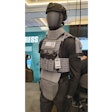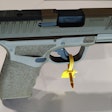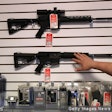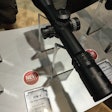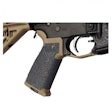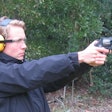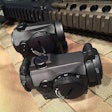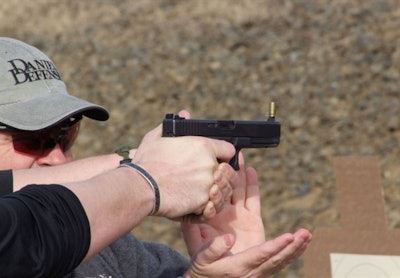 Photo: Scott Smith
Photo: Scott Smith
Editor's Note: This is the first of a two-part blog from PoliceMag.com contributor Scott Smith. In the second part, he wrote about, "Carbine Fundamentals."
To attain basic handgun and carbine training, I headed to Carthage, N.C., to meet up with Larry Vickers, a retired special operations soldier.
Many who know me may gasp, how can "you" and your shooting partner go to a basic course? The key to be high speed, low drag is to master the basics. Fundamental courses are the bread and butter for any training operation; you'll always pick up something to improve your shooting.
We gathered to shoot and learn. First, we covered the NRA basics, and then added some real-world details. The most important lesson was not sweeping yourself with the muzzle of your firearm, and keeping your finger off the trigger until you're ready to shoot.
Before loading up and shooting, Larry discussed gripping your pistol. This is where your body interacts with the firearm. It must secure, relaxed and solid. He advocates high thumbs. This position wraps the entire pistol to give you recoil control because the entire pistol grip is in contact with your hands.
Then we headed to the line at three yards to shoot at NRA-style slow-fire pistol targets. What were we working on? Why so close? We were learning trigger control — the fundamentals of trigger break and reset. At this close range, you'll be able to shoot excellent groups. When you don't follow the fundamentals, you'll know it.
Before going live, Larry uses the "dime/case drill." This can be done with one person, but it's best done with a partner. You set a dime and shell casing on the front sight and press the trigger. You should not drop the dime. This dry fire exercise teaches you a virtually perfect trigger break. It will also help you overcome slapping or jerking the trigger. You need to incorporate this trigger pull, so you get the feel of recoil and the sound that will induce flinch.
The reason Larry starts with learning trigger control is because it's the key to shooting a handgun. If you slap or jerk the trigger, the perfect grip and sight picture won't mean doo doo. A smooth, consistent trigger pull is how to improve your shooting. You also develop a mental picture of what a correct trigger pull is so you can self-diagnose or solve your shooting partner's trigger issues when you are doing accuracy shooting.
You'll quickly notice when you go live fire how you jerk or slap the trigger, dumping your rounds low left if you're right handed or low right if you're a south paw. When you catch yourself or your partners, notice it. Then immediately download and do five perfect trigger pulls with the dime/casing. This will guide get you into the groove of caressing the trigger smoothly all the time.
Once you have the trigger down then you can work on sight picture. This is lining the front sight between the notch of the rear equal spacing and tops of the front and rear-sight level. Once you do this, you'll shoot nice tight little groups where you put the front sight. If you're hitting all over, redo the drill to improve trigger control. A smooth trigger pull keeps those sights lined up, and the bullet goes where you want it to go.
After handling the basics, we started moving back, engaging the target at longer ranges. Much of the shooting was done at a moderate distance of seven to 10 yards. At this range, you start to have the target covered by the front sight. This causes minds games. How do I steady the pistol? Will the bullet hit where I aim? Can I overcome the wobble?
The answer to all of these we quickly found out was YES. Trigger control and sight picture will keep nice small clusters around and in the "X" ring. Mastering this at 10 yards is key to ringing the bell at longer distances of 50 or more yards.
The dime drill and using NRA slow-fire targets proves that you can hit "the black" or the steel at distances that will shock you. Using the slow fire target gives you a consistent aiming point to concentrate on. Concentration is what makes you a better shot. The young lady in you class went from being very uncertain about her ability to keeping her shots on the paper and mostly inside the six-inch black scoring area. I was hitting steel plates at 75 yards on the first shot.
Larry also feels you have to have a fundamental grasp of movement. We didn't spend a lot of time on it, but he explained in detail the importance of rolling heel to toe and using the knees as a spring to absorb shock when moving forward. He also explained the importance of moving toe to heel when moving to the rear and in both directions lower than your center of gravity (a.k.a. small squat). One of the keys he pointed out was lightly bending your elbows. This allows your arms to act as a shock absorber and stabilize your hands. Combining these items gives you a solid platform for shooting while moving. Unlocking the elbows is the key. If you don't, you'll exaggerate your weapon's movement visibly, and you will miss.
What makes these items important is you can practice them on your own or with your shooting partners. Doing the simple items will make you a more accurate and faster shot.
Throughout the day, we mixed up the shooting drills. There was team competition to add stress and make you perform on command, shooting steel at 75 yards, a brief piece on proper lubrication. The LAV Basic Pistol Course through Grey Group Training is a skill builder for the novice or experienced shooter.
For more information, visit the Web sites of Vickers Tactical or Grey Group Training.










